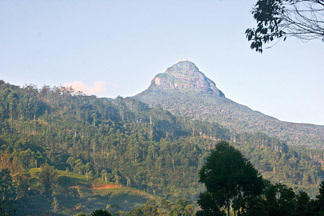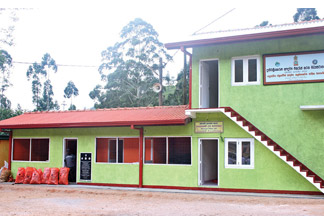Garbage disposal at holy mountain, a challenge
By Dhaneshi YATAWARA
Sri Pada isbelieved to be the home of God Sumana Saman. At the
2243-meter-high pinnacle is the holy footprint. Buddhists believe it is
the Buddha's, Hindus believe it is as Lord Shiva's, Muslims believe its
Adam's and Christians believe it is of St. Thomas. Many legends are
linked to this holy mountain. The pilgrimage is expected to be done with
a pure, clean heart.
|

The Sri Pada from a distance |
The Mahavamsa explains how the sacred footprint was imprinted by the
departing Buddha on his third visit. And another legend says that Adam
was hurled from paradise for his disobedience and stood in penance for
thousand years on one foot at the top of Adam's peak after which he
reunited with Eve on Mount Arafat overlooking Mecca.
As time passed the rituals attached to the pilgrimage seems to slowly
diminish and with it the belief of keeping this sacred environment clean
seems to be lost. Over the years many awareness campaigns were carried
out by the local and national authorities at the site as well as through
media, about the pollution this volatile environment face.
The mountain is most often scaled from December to May. During other
months it is hard to climb due to very heavy rain, extreme wind, and
thick mist. The most favourite month is April as it is the season with
the most appropriate climate that is just before the southeast monsoon.
The goal is to be on top of the mountain at sunrise, when the
distinctive shape of the mountain casts a triangular shadow on the
surrounding plain and can be seen to move quickly downward as the sun
rises.
The region along the mountain is a wildlife reserve housing many
species and including many endemic species. The Sri Pada is also the
part of the main watershed in Sri Lanka from which our largest rivers
start. One aspect of the Sri Pada season that is a constant worry for
environment conservation agencies, both Government and non Government,
is the apparent disregard shown towards this environment by pilgrims.
A primary source of concern is the dumping of non-biodegradable items
such as polythene and plastic. Pilgrims simply throw away the garbage
including polythene food wrappers in to the forest. Garbage can be seen
accumulated especially near the eateries. There are several resting
places along the route which the pilgrims use, cook and eat their meals
and sometimes spend the night. Before the mountain becomes steep for
climbing there is a river that separates the mountain peak from the
surrounding mountain range where the pilgrims take a bath and clean
themselves and change in to clean clothes. All these places are highly
prone to get polluted by careless pilgrims.

CEA authorities educating children from the Nallathanniya Tamil
Vidyalaya on garbage collection campaign

The new waste collection centre at Nallathanniya |
The garbage needs to be collected everyday and no words can explain
the difficulty of the mission when even the normal climb is difficult.
If pilgrims take a responsibility to collect their own garbage rather
than throwing them along the route and dumping them in one place at the
last point will be more environment friendly.
The Central Environment Authority following its many efforts to bring
a solution to the unending environment pollution of this World Heritage
Site at its own cost has constructed a well organised garbage collection
point at Nallathanniya. "The environment pollution in Sri Pada during
the pilgrimage season is heavily threatening the unique environment over
a period of time. Collecting garbage on the route daily has not solved
the problem properly," said Chairman of the Central Environment
Authority (CEA) Charitha Herath, explaining the role of the new place at
Nallathanniya.
The CEA has chosen Nallathanniya to construct this building as it is
where the majority of pilgrims prefer to start their journey. "Awareness
alone would not solve the problem. People need an organised place to
dispose the garbage collected during their pilgrimage too," Herath
explained.
This new construction will be a facility supporting the pilgrims to
conserve this environment.
This new building comprise separate cubicles for plastic and
polythene, glass and paper waste. There are two office rooms in this
building - one for the Ambagamuwa Pradeshiya Sabha Sub Office which will
be responsible for operating the waste collection centre and the other
office space is for CEA research centre. "The building will not be just
abandoned after opening and the Sub Office of the Ambagamuwa Pradeshiya
Sabha will be operating the centre," said Bandula Sarath Kumara,
Director of the National Post Plastic Waste Project of the CEA. This
will be a joint project of the CEA and the Ambagamuwa Pradeshiya Sabha.
"Waste simply cannot be thrown out. It can be recycled and used and has
a monetary value," he explained.
Registered under the CEA, totally there are over 150 recyclers in all
parts of the country except the Northern Province. In Hatton, which is
the closest to this area a recycling plant owned by a private individual
registered under the CEA will get the collected waste. The waste will be
collected at this point and periodically taken away for recycling.
The Ambagamuwa Pradeshiya Sabha is conducting an awareness program
along the entire route during the pilgrimage season to avoid pollution
of the environment. "Even if pilgrims carried the waste till the end of
the journey there was problem of a proper place to dump them. This new
project now addresses the problem," Sarath Kumara added.
Sri Pada belongs to one of the most valuable environment regions of
Sri Lanka - the Peak Wilderness Protected Area of the Central highlands
of the country. In 2010 when the UNESCO declared Sri Lanka's central
highlands as a world heritage Sri Pada became a precious world heritage
adding colour to its holy nature. The Central Highlands comprises with
Peak Wilderness Protected Area, the Horton Plains National Park and the
Knuckles Conservation Forest. These are Sri Lanka's montane rain forests
which shelters rare species like bear Monkey ('Trachypithecus vetulus
monticola') and Horton Plains slender Loris ('Loris tardigradus
nycticeboides').
UNESCO, describing the Sri Lanka's Montane Rain Forests says that
more than half of Sri Lanka's endemic vertebrates, half of the country's
endemic flowering plants and more than 34% of its endemic trees, shrubs,
and herbs are restricted to these diverse montane rain forests and
adjoining grassland areas.
Further in its Criteria (ix) in declaring the above mentioned three
regions as World Heritage sites the UNESCO says "In the montane forests
represented by the three serial properties, the faunal elements provide
strong evidence of geological and biological processes in the evolution
and development of taxa. The endemic purple-faced langur of Sri Lanka (Semnopithecus
vetulus) has evolved into several morphologically different forms
recognisable today.
The Sri Lankan leopard, the only representative in the island of the
genus Panthera, which diverged from other felids about 1.8 million years
ago, is a unique sub-species (Panthera pardus kotiya).
All three nominated properties provide habitat to this subspecies of
leopard, endemic to Sri Lanka." Of the 408 species of vertebrates 83
p.c. of indigenous freshwater fishes and 81 p.c. of the amphibians found
in Peak Wilderness Protected Area (to which Sri Pada belongs) are
endemic, 91 p.c. of the amphibians and 89 p.c. of the reptiles in Horton
Plains are endemic, and 64 p.c.of the amphibians and 51% of the reptiles
in the Knuckles Conservation Forest are endemic. |

